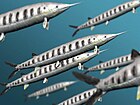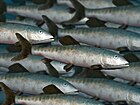Ichthyodectiformes
| Ichthyodectiformes | |
|---|---|

| |
| |
| Scientific classification | |
| Kingdom: | Animalia |
| Phylum: | Chordata |
| Class: | Actinopterygii |
| Infraclass: | Teleostei |
| Order: | †Ichthyodectiformes Bardack & Sprinkle, 1969 |
| Subgroups | |
|
See text | |
Ichthyodectiformes is an extinct order of marine stem-teleost ray-finned fish. The order is named after the genus Ichthyodectes, established by Edward Drinker Cope in 1870. Ichthyodectiforms are usually considered to be some of the closest relatives of the teleost crown group.[1]
They were most diverse throughout the Cretaceous period, though Thrissops fossils are known from the Oxfordian-Kimmeridgian boundary in the Late Jurassic. Most ichthyodectiforms ranged between 1 and 5 meters (3–15 ft) in length. All known taxa were predators, feeding on smaller fish; in several cases, larger ichthyodectiforms preyed on smaller members of the order. Some species had remarkably large teeth, though others, such as Gillicus arcuatus, had small ones and sucked in their prey. There is evidence that at least one species, Xiphactinus audax, may have been endothermic ("warm-blooded").[2]
Systematics[]
The basal phylogeny is badly resolved, leading to many ichthyodectiforms that are simply known to be rather primitive, but where nothing certain can be said about their precise relationships.
- † Taverne, 2010[4]
- †Allothrissops Nybelin, 1964
- † Taverne, 2016[5]
- † Arratia et al., 2004[6]
- †? Arratia, 2000[7]
- † Taverne, 2015[5]
- † Lees, 1990
- † Taverne & Chanet, 2000
- † Taverne & Capasso, 2018[5]
- † Taverne, 2009[5]
- †Occithrissops Schaeffer & Patterson, 1984
- † Alvarado-Ortega & Brito, 2009
- †Pachythrissops? Woodward, 1919
- †Prymnetes Cope, 1871[8]
- †Thrissops Agassiz, 1843
- †Sultanuvaisia Nesov, 1981
- † Taverne, 2010
- †Chuhsiungichthyidae Yabumoto, 1994[9]
- †Chuhsiungichthys Lew, 1974
- † Kim et al., 2014
- †Mesoclupea Ping & Yen, 1933
- †Bardackichthyidae Hacker & Shimada, 2021[10]
- †? Yabumoto et al., 2020
- † Hacker & Shimada, 2021
- †? Taverne, 2008
- †Cladocyclidae Maisey, 1991
- †Aidachar Nesov, 1981[11]
- †Chirocentrites Heckel, 1849
- † Cope, 1885
- †Cladocyclus Agassiz, 1841
- †Eubiodectes Hay, 1903
- †Ichthyodectidae Crook, 1892
- †Cooyoo Bartholomai & Less, 1987
- † Cavin et al., 2013
- †Ichthyodectes Cope, 1870
- †Xiphactinus Leidy, 1870
- †Saurodontidae Cope, 1870[12][13]
- †? Yabumoto et al., 2020
- †Gillicus Cope, 1875
- †Gwawinapterus Arbour & Currie, 2011[14]
- †? Taverne, 2008
- † Stewart, 1999
- †Saurocephalus Harlan, 1824
- †Saurodon Hay, 1830
- † Alvarado-Ortega, 2004
- † Blanco & Cavin, 2003
References[]
- ^ a b Nelson, Joseph S.; Grande, Terry C.; Wilson, Mark V. H. (2016). Fishes of the World (5th ed.). John Wiley & Sons. ISBN 9781118342336.
- ^ Ferrón, H. G. (2019). "Evidence of endothermy in the extinct macropredatory osteichthyan Xiphactinus audax (Teleostei, Ichthyodectiformes)". Journal of Vertebrate Paleontology. 39 (6): e1724123. doi:10.1080/02724634.2019.1724123.
- ^ Cavin, L.; Berrell, R. W. (2019). "Revision of Dugaldia emmilta (Teleostei, Ichthyodectiformes) from the Toolebuc Formation, Albian of Australia, with comments on the jaw mechanics". Journal of Vertebrate Paleontology. 39 (1): e1576049. doi:10.1080/02724634.2019.1576049.
- ^ Taverne, L. (2010). "Les Ichthyodectidae (Teleostei, Ichthyodectiformes) des schistes bitumineux de TAptien (Crétacé inférieur) de Guinée Équatoriale et du Gabon" (PDF). Bulletin de l'Iinstitut Royal des Sciences Naturelles de Belgique (in French). 80: 115–143.
- ^ a b c d Taverne, L.; Capasso, L. (2018). "Osteology and phylogenetic relationships of Furloichthys bonarellii gen. and sp. nov. (Teleostei, Ichthyodectidae), a tropical fish from the Upper Cretaceous of central Italy" (PDF). Geo-Eco-Trop. 42 (1): 75–88.
- ^ Arratia, G.; Scasso, R. A.; Kiessling, W. (2004). "Late Jurassic fishes from Longing Gap, Antarctic Peninsula". Journal of Vertebrate Paleontology. 24 (1): 41–55. doi:10.1671/1952-4.
- ^ Arratia, G. (2000). "Remarkable teleostean fishes from the Late Jurassic of southern Germany and their phylogenetic relationships". Fossil Record. 3 (1): 137–179. doi:10.1002/mmng.20000030108.
- ^ Blanco-Piñón, A.; Alvarado-Ortega, J. (2007). "Review of Vallecillichthys multivertebratum (Teleostei: Ichthyodectiformes), a Late Cretaceous (early Turonian) "Bulldog fish" from northeastern Mexico" (PDF). Revista Mexicana de Ciencias Geológicas. 24 (3): 450–466.
- ^ Kim, H.; Chang, M.; Wu, F.; Kim, Y. (2014). "A new ichthyodectiform (Pisces, Teleostei) from the Lower Cretaceous of South Korea and its paleobiogeographic implication". Cretaceous Research. 47: 117–130. doi:10.1016/j.cretres.2013.11.007.
- ^ Hacker, R. J.; Shimada, K. (2021). "A new ichthyodectiform fish (Actinopterygii: Teleostei) from the Arlington Member (mid-Cenomanian) of the Upper Cretaceous Woodbine Formation in Texas, USA". Cretaceous Research. 123: 104798. doi:10.1016/j.cretres.2021.104798.
- ^ Cavin, L.; Boudad, L.; Tong, H.; Läng, E.; Tabouelle, J.; Vullo, R. (2015). "Taxonomic Composition and Trophic Structure of the Continental Bony Fish Assemblage from the Early Late Cretaceous of Southeastern Morocco". PLOS ONE. 10 (5): e0125786. doi:10.1371/journal.pone.0125786.
- ^ Cope, E. D. (1870). On the Saurodontidæ. Proceedings of the American Philosophical Society 11:529-538
- ^ Cope, E. D. (1873). On two new species of Saurodontidae. Proceedings of the Academy of Natural Sciences of Philadelphia 25:2-339
- ^ Vullo, R., Buffetaut, E. and Everhart, M.J. (2012). "Reappraisal of Gwawinapterus beardi from the Late Cretaceous of Canada: a saurodontid fish, not a pterosaur." Journal of Vertebrate Paleontology, 32(5): 1198-1201. doi:10.1080/02724634.2012.681078
| Wikimedia Commons has media related to Ichthyodectiformes. |
- Ichthyodectiformes
- Prehistoric ray-finned fish orders
- Late Jurassic first appearances
- Late Cretaceous extinctions
- Prehistoric ray-finned fish stubs






